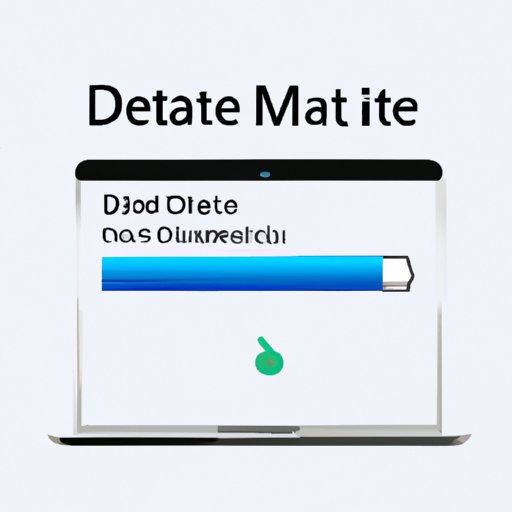
I. Introduction
Do you often find your downloads folder cluttered with files you no longer need? Have you been struggling to free up space on your Mac? If yes, then this article is for you. In this comprehensive guide, we’ll explore the different ways to delete downloads on a Mac and provide tips for proper download management.
II. Step-by-Step Guide on How to Delete Downloads
Manually deleting downloads is a simple and straightforward process. Here’s how to do it:
- Locate the ‘Downloads’ folder on your Mac
- Select the files you want to delete
- Right-click on the selection and click ‘Move to Bin’
- Finally, right-click on the Bin and click ‘Empty Bin’
It’s important to remember to double-check the files you are deleting, making sure you don’t delete any important files that you may need later. Also, you might consider making backups of your important downloads before deleting them, just to be safe.
III. Using a Third-Party App to Delete Files
Some third-party apps can help make the process of deleting downloads even easier. Here are some of the best third-party apps available:
- CleanMyMac X
- AppCleaner
- Easy Duplicate Finder
Each of these apps have user-friendly interfaces and are designed to help you quickly and easily delete downloads. To use them, simply download the app, select the downloads you want to delete, and then follow the prompts.
One potential drawback of using a third-party app is that some might try to sell you on additional features that you don’t need. However, as long as you use these apps from reputable sources, you should be able to avoid this problem.
IV. How to Automate the Deletion of Downloads
If you want to keep your downloads folder under control without spending too much time deleting files manually, automating the process might be the solution for you. There are a variety of software instruments that can be used to automate deletion, including Automator, Hazel, and CleanMyMac X.
Here’s how to automate the deletion of downloads using Automator:
- Open Automator on your Mac
- Click on ‘File’ and select ‘New’
- Choose ‘Folder Action’ and click ‘Choose’
- Select the downloads folder you want to automate
- Under ‘Actions’, select ‘Files & Folders’ and then select ‘Move Finder Items’
- Drag and drop ‘Move Finder Items’ to the workflow area
- In the ‘To:’ field, select the Bin
- Name your workflow and save it
Once you’ve created the workflow, your Mac will automatically delete downloads that have been in your Downloads folder for a certain amount of time. This will keep your downloads folder clean and tidy without you having to do anything manually.
V. Comparing Different Methods for Deleting Downloads on a Mac
Let’s compare the three different methods for deleting downloads on your Mac:
Manual Deletion
Pros:
- Free
- User-friendly
Cons:
- Can be time-consuming
- Can be prone to errors if you delete the wrong files
Using Third-Party Apps
Pros:
- Efficient and quick
- User-friendly interfaces
Cons:
- May try to sell you on additional features
- Can require extra payment
Automating Download Deletion
Pros:
- Efficient and automatic, saving time
- Keep your downloads folder organized without effort
Cons:
- Setting it up could be complicated
VI. Comprehensive Guide to Cleaning Up Your Mac
Deleting downloads is just one part of keeping your Mac clean and running smoothly. Here are some tips for a comprehensive cleaning process:
- Clear cache and temporary files
- Remove duplicates
- Uninstall unused applications
- Free up disk space
- Organize your files and folders
By following these tips, you can keep your Mac running fast and efficiently for longer periods of time.
VII. Conclusion
In summary, deleting downloads is a crucial part of proper download management. While there are different methods available, manual deletion, third-party apps, and automation all have their respective pros and cons. Ultimately, the method you choose depends on your personal preference and comfort level with each option. With this guide, we hope you’ll be able to delete downloads with confidence and keep your Mac running smoothly.
Now, it’s time to take action and apply all the tips we’ve shared with you.





